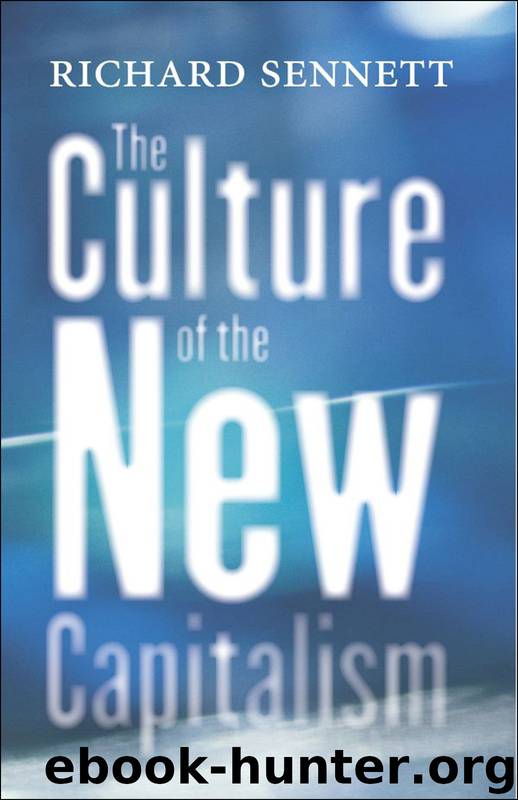The Culture of the New Capitalism by Richard Sennett

Author:Richard Sennett
Language: eng
Format: epub
Publisher: Yale University Press
Published: 2006-03-08T16:00:00+00:00
To understand this machinery, we need ever to keep in mind what seems a self-evident fact, and a subtlety. The self-evident fact is that judgments of ability are Janus-faced: at one and the same time they single out ability and eliminate incompetence or lack of ability. This self-evident fact looks a little more problematic, though, if we recur to social capitalism as Bismarck first conceived it. His institutions promoted by merit—but also by seniority. The machinery aimed to include the masses, whether competent or not, so long as the masses put in their time and served the institution.
The search for talent in modern society, particularly in dynamic institutions, does operate within a framework of social inclusion. Just those tests, judgments, and milestones which reward the best serve as the basis for shedding others below this elite level. The Janus-faced search for talent is conspicuous when businesses are combined or when a single business decides to downsize. Bureaucracies often try to legitimate getting rid of layers or categories of people by claiming that only the worthy remain. Of course this can be a self-serving fiction, but such institutions are driven to justify impersonal, hasty, or arbitrary change on the basis of shedding deadwood or other highly personalized judgments of who should remain.
The sociologist Pierre Bourdieu called this Janus-faced relationship “distinction,” the mass disabled or penalized tacitly as educational, work, and cultural institutions confer elite status explicitly. 5 For Bourdieu the real point of distinction is to create a mass in shadow, by putting a spotlight on the elite. My own view is that the spotlight shows a confused scene. This is the subtle aspect of the meritocratic talent search—the illumination and definition of talent itself.
In craftsmanship we are able to judge how well someone performs by looking at the concrete results of their labors. To displaced or discarded workers, those results at least make legible why they have been cast aside; the quality of Indian software programs and Chinese manufactured goods are solid facts. It might seem that the meritocracy machinery of testing and on-the-job evaluation is equally solid. The measures, after all, are standardized, numbers often taking the place of names on tests to assure objectivity. But in fact the bureaucratic machinery chases after something quite intangible; one can quantify what kinds of work seem autonomous, for example, but not what specifically an autonomous act is. Craftsmanship requires mastering and owning a particular domain of knowledge; this new version of talent is not content-specific or content-determined. Cutting-edge firms and flexible organizations need people who can learn new skills rather than cling to old competencies. The dynamic organization emphasizes the ability to process and interpret changing bodies of information and practice.
Within the meritocratic scheme there is thus a soft center in evaluating talent; that soft center concerns talent conceived in a particular form, as potential ability. In work terms, a person’s human “potential” consists in how capable he or she is in moving from problem to problem, subject to subject. The ability to move around in this way resembles the work of consultants, writ large.
Download
This site does not store any files on its server. We only index and link to content provided by other sites. Please contact the content providers to delete copyright contents if any and email us, we'll remove relevant links or contents immediately.
Cecilia; Or, Memoirs of an Heiress — Volume 1 by Fanny Burney(31332)
Cecilia; Or, Memoirs of an Heiress — Volume 3 by Fanny Burney(30934)
Cecilia; Or, Memoirs of an Heiress — Volume 2 by Fanny Burney(30889)
The Great Music City by Andrea Baker(21313)
We're Going to Need More Wine by Gabrielle Union(18072)
Bombshells: Glamour Girls of a Lifetime by Sullivan Steve(13108)
Pimp by Iceberg Slim(12931)
All the Missing Girls by Megan Miranda(12747)
Fifty Shades Freed by E L James(12451)
Norse Mythology by Gaiman Neil(11883)
Talking to Strangers by Malcolm Gladwell(11876)
Crazy Rich Asians by Kevin Kwan(8349)
Mindhunter: Inside the FBI's Elite Serial Crime Unit by John E. Douglas & Mark Olshaker(7834)
The Lost Art of Listening by Michael P. Nichols(6472)
Enlightenment Now: The Case for Reason, Science, Humanism, and Progress by Steven Pinker(6405)
Bad Blood by John Carreyrou(5769)
The Four Agreements by Don Miguel Ruiz(5510)
Weapons of Math Destruction by Cathy O'Neil(5036)
We Need to Talk by Celeste Headlee(4868)
